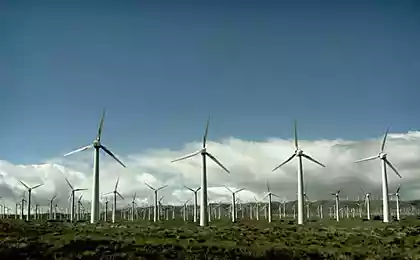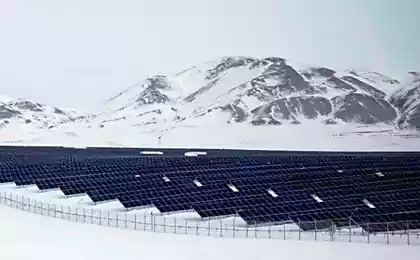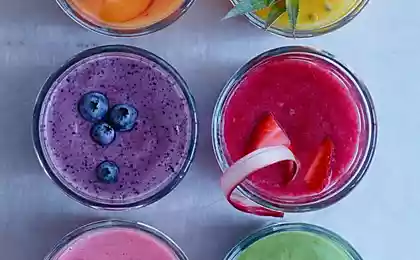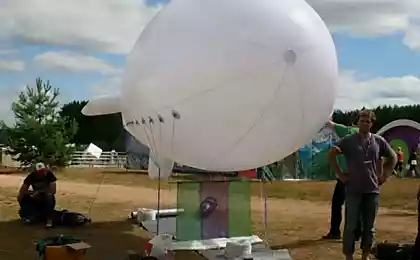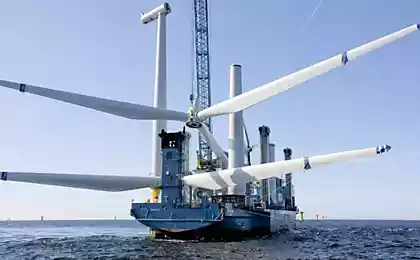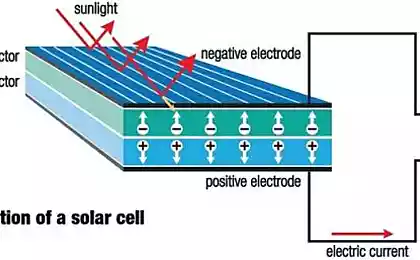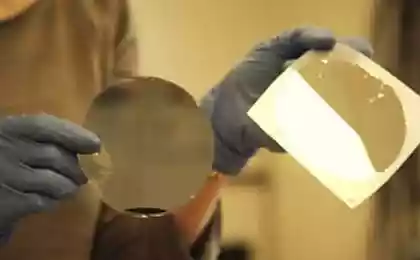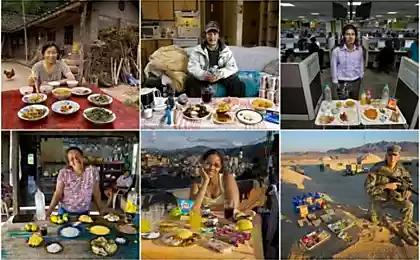794
Full energy autonomy or how to survive with solar panels in the Outback
It all started with the fact that I bought a plot of land in the village, past which did not pass the electrical wires. "It's nothing,' I thought. — Because by law I have to connect to the power grid for 6 months from the date of conclusion of the contract". If I knew that I would have to develop an Autonomous energy supply and plunge into the world of solar energy...

I will try to cover the theoretical justification for its choice and calculations that will facilitate the understanding of the scope of investments to build your own power system.
The second part will describe the practical realization of their ideas with the economic calculations, applied equipment and circuitry for the working of the power system. Also describe the advantages, shortcomings and mistakes in the project.
In the third, when it comes, will tell about the plans for the integration of an Autonomous power system and a conventional network grid in a private home.
The realization that electricity yet and the house is already assembled, it is in spring when I started building and finishing the season. And if the house were collected with the help of a rattling diesel generator, to live with the noise in the village is impossible, and expensive for the sake of a drill or pair of lamps to drive the 2.5 kW gasoline generator. It is very easy to the first rule: in the village of orenburgselenergo if there is a need for electricity at any time. Network is unstable and to fix them nobody will be in the first minutes after failure. The second rule: the generator should run on the same fuel as the car. If the fuel suddenly ran out, can be drained from the machine, and if the tank in the car is dry, you can conduct a reverse procedure.
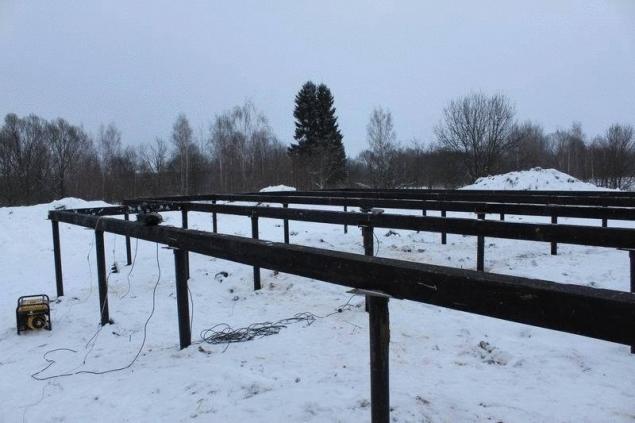
If you look in the left corner, you can see how the generator works for one drill and radio. After this picture started to slip in the idea that electricity should not so much, but often. For example, in the evening you need to light the house, which takes about 100 watts of power. Vitali thought about buying a second, low power gasoline generator, but was turned down for a number of reasons: sound, maintenance, mechanics, and so wear and sooner or later, failure. Needed something Autonomous, simple, reliable.
Having studied the forum of autonomico, I read hundreds of branches and learning to distinguish a single crystal from a polycrystal, it was decided to use solar energy for the benefit of the particular home. After all on habré many posts about how once the cellular company in a remote region spent a lot of rubles and can save even more and everything is clear, with his own hands and by their example.
Let's move on to theory. The main, than to have to fight in the house with Autonomous energy system (hereinafter the submarine), so it is with the desire for all households to include kettles, irons, microwave ovens and other appliances that consume crazy kilowatts of energy. For Hairdryers and irons you can start the generator.

So, the first thing you want to exclude most of the appliances that we use in everyday life: electric kettles, electric cookers and so on. The replacement will be any gas stove and a gas cylinder which can fill almost any gas stations. So, we cook and heat with gas is the third rule avtonomki.
The use of led lighting. You can take the led Assembly, individual LEDs or led strip. In the latter case can be purchased wholesale in the Chinese online store for the whole house and well, shaknovich. The main task is to select the voltage equal to the voltage of the energy storage in the house. Because any conversion will eat up the extra Watts. Hence, the fourth rule is: led lighting wherever possible.
Motion sensors seriously help save electricity is also identified experimentally. On the way to the toilet, the stairs to the second floor or in the hallway it is best to put a motion sensor and a led strip. This will avoid walking in the dark to the light switch and no unnecessary energy loss when someone forgot to click the button.
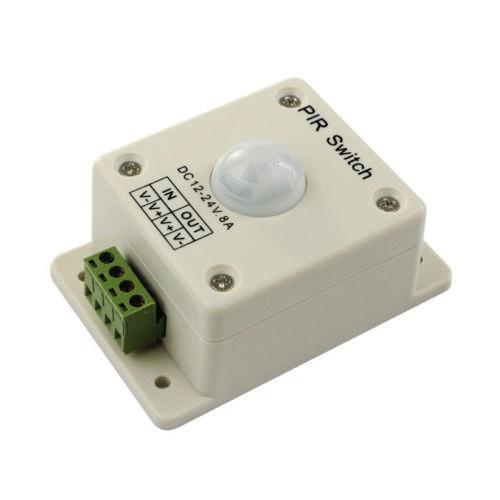
Cost of such a sensor will be about 300-350 rubles, but it will save a lot of nerves and energy. Own consumption is negligible compared to included and neglected lighting. One amusing case study: Pets quickly calculated the range of the sensor and the nights had fun entering and leaving the zone of visibility, including a light.
And now about the technology that will be needed to create a submarine on solar energy:
1. Solar panels:

2. The charge controller from the solar panels:

3. Batteries. When discussing the type of batteries was broken so many copies, that even not want to remember. One of the most difficult challenges and the most expensive part of the system:
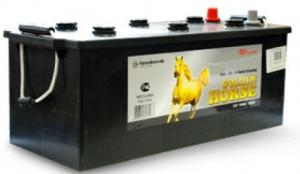
4. Inverter from DC to AC with voltage of 220V:

This four main elements of Autonomous energy systems based on solar batteries. On the extension of functionality I'll explain in a second, practical, and will paint the minimal independence for a country house, where you want the evening to watch TV, to go from the laptop to the network and when the light bulb to sit at the table. All considered on the basis of the average strip of Russia in the period from April to September. At other times of year the sun is noticeably smaller, and the holiday season is almost closed or not yet opened.
Take raw consumption:
1. the average notebook with a consumption of 80 WH will work 5 hours a day
2. the average TV consumption of 40 W*h (LC) will work 3 hours a day
3. lighting 3 led strips (24 W\PC), which is enough for a room of about 40 sq. m. will work 4 hours
We have a total need of energy: 808 W*h
If the form of energy storage will be selected a regular car battery with a voltage of 12 V, then during the evening will be spent in 67 Ah. Not to drop the battery and prolong its service life, it is recommended to discharge the battery no more than 30%, and therefore the required capacity is 200 Ah and above. In addition, during daylight you will need to fill spent uppercase, but still need to consider the efficiency and variability of the sun to pick up the necessary number of solar panels. Let's say that the sun will Shine for 8 hours, they will be cloudy for 3 hours and the efficiency of power generation will fall. Thus, we have to compensate 67 Ah in 5 hours. It would seem that nothing could be simpler: 14 And pour in 5 hours and all, but solar energy has a lot of nuances. The batteries do not accept charge linearly to the "filling" of the battery energy receiving current is reduced and the last hours of charging is extremely slow.
Turning to the calculation of the necessary equipment that you will need to buy for the electrification of holiday cottages, we get:
1. Solar battery 2 PCs x 100 watts — 15000 R
2. Charge controller the easiest 800R
3. The battery 190 Ah — 8500 R
4. 3 led strip — 1200 R.
5. Inverter 12V-220V — 2000P.
Total: 27500 rubles
The equipment was considered the most expensive because of the minimum comfort, which is described above. If you liked the material and would like to see the implementation of more powerful and operating systems, please let me know, so I began writing the second part.
Real solar submarine to the end user consists of the money spent, samples, installation of devices and training of households to use electricity sparingly. Moreover, the last paragraph should pay attention really, since the submarine involves a very special approach to energy consumption and even the restructuring of habitual actions.

Since solar panels are the most visible part of the system, and even convert the sun's energy into electricity, then it should start with them. There are two ways to obtaining solar panels: do it yourself, or buy ready-made. I must say that the final cost of the end product when producing multiple panels and without experience will cost about the same amount as the final panel of the same capacity, but produced at the plant. But it's interesting to do it yourself.
Here it is necessary again to add a bit of theory. There are three available to buyers, for sane money, technology solar panels, made up of different cells: monocrystalline, polycrystalline and amorphous silicon. They differ in structure and it is even visible to the eye. I will try to explain as simple as possible, but those who want to experience the difference of chemical compositions can view information for yourself — do not overload the article.
Amorphous silicon is the most promising technology for manufacture. Allows the manufacture of fibre composite panels and to generate electricity in diffuse light, that is, in cloudy weather, but quickly degraded, resulting in reduced efficiency.
The crystal — clear cells from primary silicon. Usually, the black of the plate without inclusions, is almost square in shape with rounded edges. Sometimes sawn in half to increase the voltage of the line items.
The polycrystal cells from recycled silicon or not very clean. You're probably using a scrap of the single crystal.
Battery types are sorted by decreasing their cost. And if the second and third options are even close, the first noticeable breaks in the value, and eventually decreases energy production. For making your own Solar Panel (more SP or SB — Solar Battery) in China was ordered batch of solar cells grade B Grade quantity per couple SAT. It is necessary to check that the kit include terminal boxes, bus for the connection of cells among themselves and at least a couple feet of cable. There was, however, ordered the MC4 connectors to connect the batteries. Russia had ordered the production of enlightened tempered glass thickness of 4 mm. This thickness is due to the need to protect themselves from all sorts of icicles(hail) and other weather conditions (a targeted strike with a stone is unlikely to survive), and the glass should be enlightened to increase the efficiency of the elements. For framing glass and protect them from chipping and ease of installation were purchased aluminium angle 30x30 and necessary hardware to him. To connect solar panels to the system were selected stranded copper cable with a cross section of 6 sq. mm To charge was ordered in the same China the PWM controller, and to power devices 220V — simple automotive inverter with a capacity of 100 Chinese Watts. Later I'll explain the difference between normal and Chinese Watts.
Energy # 1. Budget
Self manufacturing solar panel
Thus, the Assembly. The modules came in the box and some of them have been broken, as in the first photo. For this purpose, stock generally has about 10 pieces. I complained to the Chinese in a letter and he sent me another 10 cells. Each cell was given 0.5 and 4 And according to the Chinese sellers. That is, each module is 2 watts. To charge the battery must have a voltage above 14.4 V Volts, it is necessary to merge cells in series. Looking at the factory panels and using the practice of many homebrew, it was decided to combine one glass two chains of 36 items, receiving 18 Volts and 8A peak. That is, one panel can generate up to 144 watts of power, which has never happened. The reasons will be discussed later, but while the manufacturer.
The procedure is simple. Solder the booths:
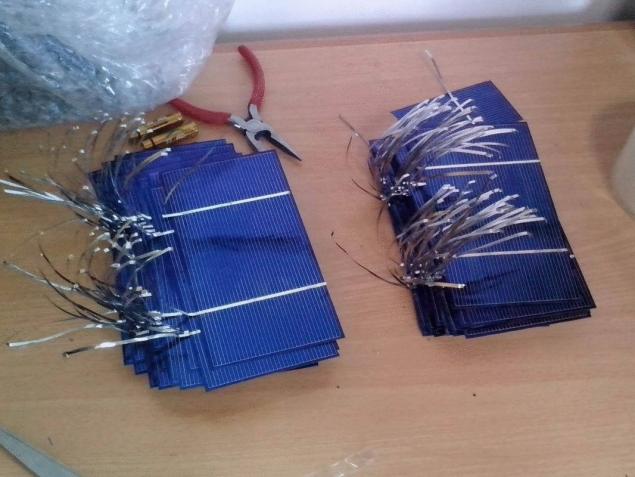
Preparing a glass with frame:
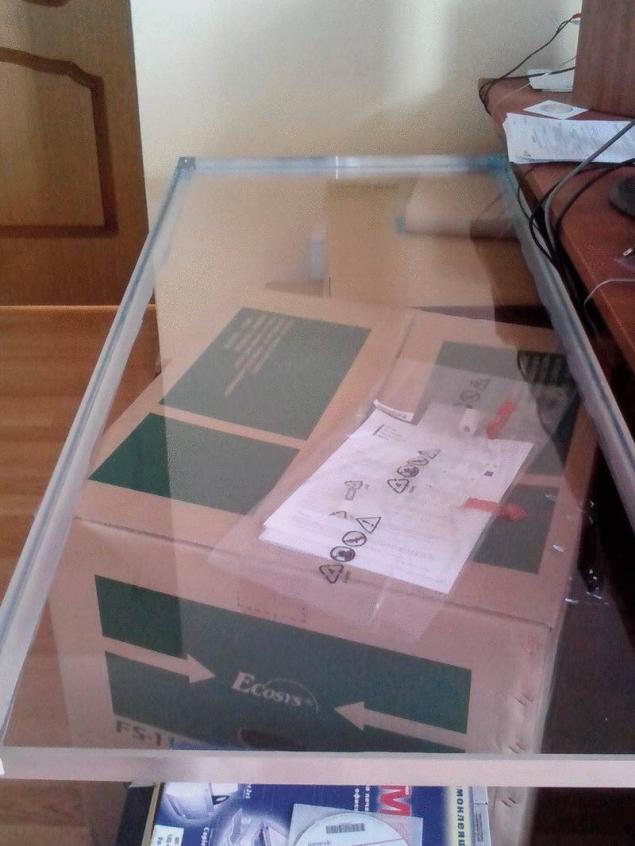
Stacked, the solder print and solder bus wire, and then pour a special compound to seal all plates. People poured sealant, various mastics, I liked the finished compound production company in St. Petersburg. It's nice that the production of Russian, so giving money was not a pity, and the result is pleasantly pleased. The findings of the contacts it would be good to put a sealed box with a diode that will prevent the loss of power system with series connection, if one of the batteries will be darkened. The box came complete with cells.

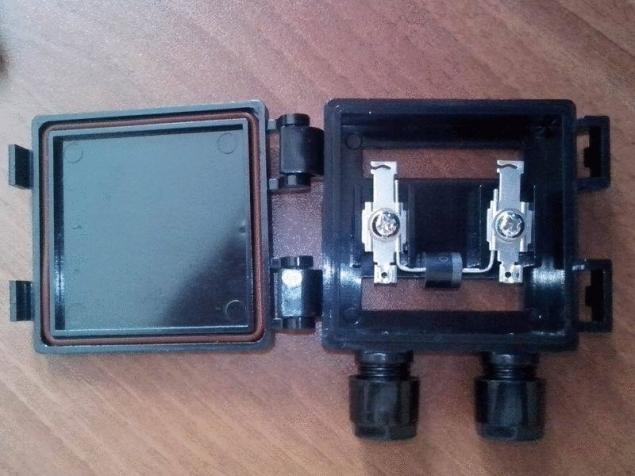
In the end, I got two solar panels with an estimated capacity of 288 watts.
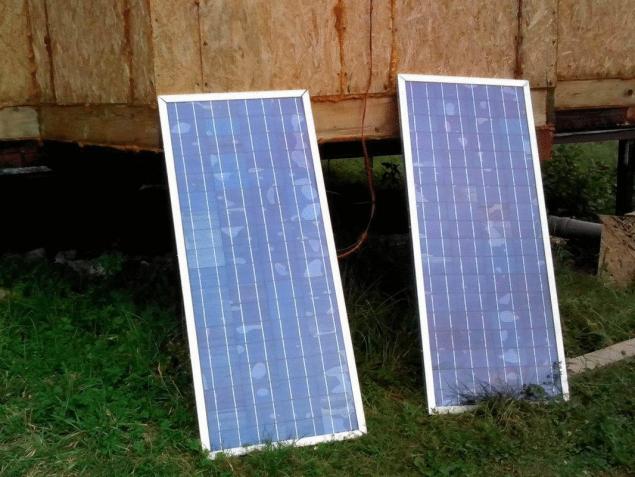
But there is a lot of conventions. When heated by solar panels, its efficiency falls even from the estimated 20 percent. In addition, affected Naropa elements and micro-cracks, which inevitably arise when soldering. As a result of measurements on the summer sun I got 40 watts with each panel, that is, the result is three times smaller than expected. The price of this panel came about 6000-6500 roubles, while a factory panel with shipping costs 7000-7500 rubles. So I finished the Amateur and in the future, buy only the factory panel.
The choice of base voltage
Perhaps this is one of the first decisions to be made when designing solar panels. The fact that the system of solar generated voltage is multiple of 12, since most batteries have this voltage. Even larger batteries collected from cells at 2V, often collected at 12, 24, 36 or 48 Volts. You've got to remember the physics formula electrical power: P=U*I. it follows that, with equal capacity, increasing the voltage, we decrease the current. It is quite natural that reducing the current will result in a decrease in the load circuitry and reducing the wire size, but is infinite to increase the voltage is impossible. Then there is the following problem: DC, unlike AC, when increasing the voltage above 36 Volts is far more dangerous to humans. If you do not delve into the theory, then AC voltage 220V hand to tear off most of the time, but almost never permanent. In addition to this, for low voltage you can vote though, because the 12V is the typical voltage of a car battery, which means there are many different techniques designed for this voltage. In addition, capacity-battery capacity is possible by simply adding in parallel conventional batteries, while with a higher voltage would have to buy the batteries in pairs, threes or fours. There is another unpleasant moment in the series connection of batteries: the imbalance of the cells, which leads to the failure of the first one cell, then the entire battery and of the whole chain, if not in time to track down the problem.
My choice: 12 In
The choice of charge controller solar
There are two basic types of controllers: PWM or PWM controller and MPPT or Maximum Power Point Tracking — the Tracking of the Maximum Power Point.
The first type is the simplest and the most familiar with the PWM do not need to explain, but for the rest as simple as possible to achieve maximum battery charge level, the controller delivers a current surge to the battery, not allowing it to be recharged. Plus this scheme: simplicity, and therefore low cost. Minus: you can connect a battery, the nominal voltage that matches the nominal battery voltage.
MPPT controllers are more complex, more expensive, but have a huge advantage: solar panels can be connected in series, thereby increasing the voltage to the controller and reducing the current that allows the use of thinner wires and lower losses in transmission of energy to the controller. And, the efficiency of these controllers is higher because they periodically scan currents at various voltages and choose the maximum power point. Hence the name.
To their own panels, I bought a Chinese PWM controller, giving the charge to 30A, that is 360 W at a voltage of 12 V or 720 watts at a voltage of 24V. But as the system is set to 12V, the limit is 30A or 3 solar panels connected in parallel.
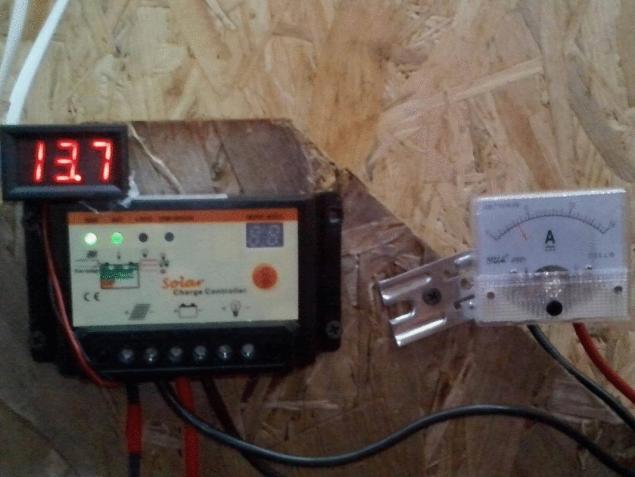
Added ordered from the same voltmeter and ammeter to see what is the status of the battery and what is the charge supplied to the battery. The battery was chosen as the cheapest lead-acid, capacity of 190 Ah, because I still believe that I'm about to connect the power of electricity.
Select the inverter
Go to the most entertaining item in our system. Let's start with the fact that the inverters in addition to power, easily divided into two types: pure sine wave output and modified sine wave ( also referred to approximated sine wave or square wave). First give a clean sinusoidal signal, the second one have the step on the chart:
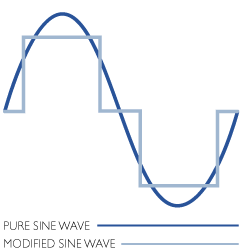
For most equipment there is no difference, and if you connect a simple voltmeter, the readings will be about the same. But if you compare the prices of both types of devices of equal power, will find that the price differs considerably. Do I have to pay for pure sine and what is it for? As shown, most devices are easy to get along with modified sine wave, although some engines, for example, compressors of refrigerators, starting to warm up more and increases the risk of premature failure. In addition, if connected to a modified sine wave, the audio system, you will hear a noticeable noise that is not happy when you want to enjoy good sound. From my own experience I can say that from modified sine wave refused to work only a washing machine — all other devices worked successfully. If there is amount on a good inverter, you should choose pure sine if the other devices sensitive to the purity of the signal.
Choose a power inverter
In this matter a lot of nuances that affect the choice of inverter. The rule: the whole plan is summed load power and multiplied by two. For example: 4 lamps 60 Watt washing machine 800 Watts+ laptop 80 Watt+100 Watt Refrigerator+TV 50 Watts. It would seem that the maximum consumption is 240+800+80+100+50= 1270 W and it is enough to take the inverter at 1300-1500 watts, but! Different loads behave differently. For example, the starting current of the refrigerator can reach ten times the during the launch, so it will require 1 kW of power instantly, but if at that time will be included light and washing machine, the inverter will just fall out in an error, if you do not burn. In addition, the Chinese inverters of this type to 1500 W have been unable to run the fridge with a rated power of 100 W consumption of energy. The experiment was carried out when the fridge started from a generator, and then quickly switched to the inverter using the phase switch. Was able to power the fridge from Chinese inverter 600 W — barbarism, it is difficult, but it worked. The trouble one: the second time running the refrigerator this inverter can not. The hoax was to expose the settings of the refrigerator on maximum cold. And the fridge freezes up until will not be disconnected. So you can numerosity per day of light products, and at night to turn it off.
So, the inverter capacity should be such as to provide a double supply of your regular consumption of devices or ten times to start the engine.
My choice: two Chinese inverter with a capacity of 1000 and 600 watts.
Duplication
When choosing a cheap and simple components, it is better to put on duplicate systems. This will allow you to stay without electricity in case of failure of any element. This reassurance won't be expensive but will provide peace of mind and a stable power supply.
In General, the first set avtonomki looked like this:
1. Two homemade solar panels with a total output of 80 watts
2. A PWM charge controller battery with a maximum current up to 30A
3. Automotive lead-acid battery with the capacity of 190 Ah
4. The inverter is 600 watts and 100 watts with modified sine wave
Diagram operating budget avtonomki looks like this:
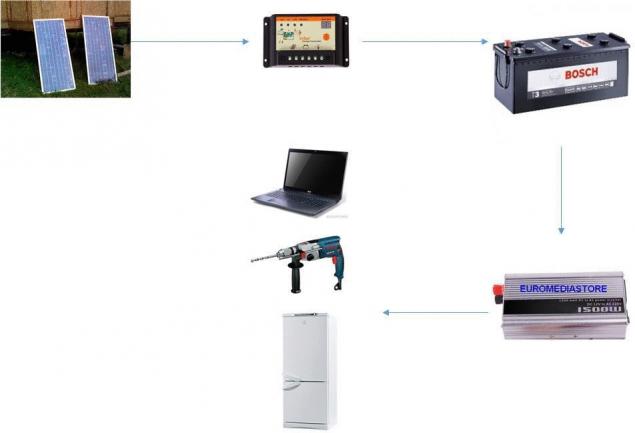
Please note that the inverter connects directly to the battery, even if it consumes all the power the solar panels. In addition, it is necessary to avoid breakage of the power controller when connected to solar because it threatens damage to the controller.
The first year my solar submarine existed in this form and allow you to charge gadgets in the evenings to stay light and bright Sunny days to work with power tools like drills or jigsaws.
The material turned out longer than expected, so the second version of a solar avtonomki, which cost slightly more but allows you to use a powerful tool to engage a pumping station, and indeed to give up a summer of petrol I will describe in the next article. What distinguishes the good China from the China of Europe? Is it worth buying expensive equipment on Ebay? I'll also give the answer to the main question: was it worth it? Please ask specifying questions that I will answer in the next part. published
Source: habrahabr.ru/post/251449/

I will try to cover the theoretical justification for its choice and calculations that will facilitate the understanding of the scope of investments to build your own power system.
The second part will describe the practical realization of their ideas with the economic calculations, applied equipment and circuitry for the working of the power system. Also describe the advantages, shortcomings and mistakes in the project.
In the third, when it comes, will tell about the plans for the integration of an Autonomous power system and a conventional network grid in a private home.
The realization that electricity yet and the house is already assembled, it is in spring when I started building and finishing the season. And if the house were collected with the help of a rattling diesel generator, to live with the noise in the village is impossible, and expensive for the sake of a drill or pair of lamps to drive the 2.5 kW gasoline generator. It is very easy to the first rule: in the village of orenburgselenergo if there is a need for electricity at any time. Network is unstable and to fix them nobody will be in the first minutes after failure. The second rule: the generator should run on the same fuel as the car. If the fuel suddenly ran out, can be drained from the machine, and if the tank in the car is dry, you can conduct a reverse procedure.

If you look in the left corner, you can see how the generator works for one drill and radio. After this picture started to slip in the idea that electricity should not so much, but often. For example, in the evening you need to light the house, which takes about 100 watts of power. Vitali thought about buying a second, low power gasoline generator, but was turned down for a number of reasons: sound, maintenance, mechanics, and so wear and sooner or later, failure. Needed something Autonomous, simple, reliable.
Having studied the forum of autonomico, I read hundreds of branches and learning to distinguish a single crystal from a polycrystal, it was decided to use solar energy for the benefit of the particular home. After all on habré many posts about how once the cellular company in a remote region spent a lot of rubles and can save even more and everything is clear, with his own hands and by their example.
Let's move on to theory. The main, than to have to fight in the house with Autonomous energy system (hereinafter the submarine), so it is with the desire for all households to include kettles, irons, microwave ovens and other appliances that consume crazy kilowatts of energy. For Hairdryers and irons you can start the generator.

So, the first thing you want to exclude most of the appliances that we use in everyday life: electric kettles, electric cookers and so on. The replacement will be any gas stove and a gas cylinder which can fill almost any gas stations. So, we cook and heat with gas is the third rule avtonomki.
The use of led lighting. You can take the led Assembly, individual LEDs or led strip. In the latter case can be purchased wholesale in the Chinese online store for the whole house and well, shaknovich. The main task is to select the voltage equal to the voltage of the energy storage in the house. Because any conversion will eat up the extra Watts. Hence, the fourth rule is: led lighting wherever possible.
Motion sensors seriously help save electricity is also identified experimentally. On the way to the toilet, the stairs to the second floor or in the hallway it is best to put a motion sensor and a led strip. This will avoid walking in the dark to the light switch and no unnecessary energy loss when someone forgot to click the button.

Cost of such a sensor will be about 300-350 rubles, but it will save a lot of nerves and energy. Own consumption is negligible compared to included and neglected lighting. One amusing case study: Pets quickly calculated the range of the sensor and the nights had fun entering and leaving the zone of visibility, including a light.
And now about the technology that will be needed to create a submarine on solar energy:
1. Solar panels:

2. The charge controller from the solar panels:

3. Batteries. When discussing the type of batteries was broken so many copies, that even not want to remember. One of the most difficult challenges and the most expensive part of the system:

4. Inverter from DC to AC with voltage of 220V:

This four main elements of Autonomous energy systems based on solar batteries. On the extension of functionality I'll explain in a second, practical, and will paint the minimal independence for a country house, where you want the evening to watch TV, to go from the laptop to the network and when the light bulb to sit at the table. All considered on the basis of the average strip of Russia in the period from April to September. At other times of year the sun is noticeably smaller, and the holiday season is almost closed or not yet opened.
Take raw consumption:
1. the average notebook with a consumption of 80 WH will work 5 hours a day
2. the average TV consumption of 40 W*h (LC) will work 3 hours a day
3. lighting 3 led strips (24 W\PC), which is enough for a room of about 40 sq. m. will work 4 hours
We have a total need of energy: 808 W*h
If the form of energy storage will be selected a regular car battery with a voltage of 12 V, then during the evening will be spent in 67 Ah. Not to drop the battery and prolong its service life, it is recommended to discharge the battery no more than 30%, and therefore the required capacity is 200 Ah and above. In addition, during daylight you will need to fill spent uppercase, but still need to consider the efficiency and variability of the sun to pick up the necessary number of solar panels. Let's say that the sun will Shine for 8 hours, they will be cloudy for 3 hours and the efficiency of power generation will fall. Thus, we have to compensate 67 Ah in 5 hours. It would seem that nothing could be simpler: 14 And pour in 5 hours and all, but solar energy has a lot of nuances. The batteries do not accept charge linearly to the "filling" of the battery energy receiving current is reduced and the last hours of charging is extremely slow.
Turning to the calculation of the necessary equipment that you will need to buy for the electrification of holiday cottages, we get:
1. Solar battery 2 PCs x 100 watts — 15000 R
2. Charge controller the easiest 800R
3. The battery 190 Ah — 8500 R
4. 3 led strip — 1200 R.
5. Inverter 12V-220V — 2000P.
Total: 27500 rubles
The equipment was considered the most expensive because of the minimum comfort, which is described above. If you liked the material and would like to see the implementation of more powerful and operating systems, please let me know, so I began writing the second part.
Real solar submarine to the end user consists of the money spent, samples, installation of devices and training of households to use electricity sparingly. Moreover, the last paragraph should pay attention really, since the submarine involves a very special approach to energy consumption and even the restructuring of habitual actions.

Since solar panels are the most visible part of the system, and even convert the sun's energy into electricity, then it should start with them. There are two ways to obtaining solar panels: do it yourself, or buy ready-made. I must say that the final cost of the end product when producing multiple panels and without experience will cost about the same amount as the final panel of the same capacity, but produced at the plant. But it's interesting to do it yourself.
Here it is necessary again to add a bit of theory. There are three available to buyers, for sane money, technology solar panels, made up of different cells: monocrystalline, polycrystalline and amorphous silicon. They differ in structure and it is even visible to the eye. I will try to explain as simple as possible, but those who want to experience the difference of chemical compositions can view information for yourself — do not overload the article.
Amorphous silicon is the most promising technology for manufacture. Allows the manufacture of fibre composite panels and to generate electricity in diffuse light, that is, in cloudy weather, but quickly degraded, resulting in reduced efficiency.
The crystal — clear cells from primary silicon. Usually, the black of the plate without inclusions, is almost square in shape with rounded edges. Sometimes sawn in half to increase the voltage of the line items.
The polycrystal cells from recycled silicon or not very clean. You're probably using a scrap of the single crystal.
Battery types are sorted by decreasing their cost. And if the second and third options are even close, the first noticeable breaks in the value, and eventually decreases energy production. For making your own Solar Panel (more SP or SB — Solar Battery) in China was ordered batch of solar cells grade B Grade quantity per couple SAT. It is necessary to check that the kit include terminal boxes, bus for the connection of cells among themselves and at least a couple feet of cable. There was, however, ordered the MC4 connectors to connect the batteries. Russia had ordered the production of enlightened tempered glass thickness of 4 mm. This thickness is due to the need to protect themselves from all sorts of icicles(hail) and other weather conditions (a targeted strike with a stone is unlikely to survive), and the glass should be enlightened to increase the efficiency of the elements. For framing glass and protect them from chipping and ease of installation were purchased aluminium angle 30x30 and necessary hardware to him. To connect solar panels to the system were selected stranded copper cable with a cross section of 6 sq. mm To charge was ordered in the same China the PWM controller, and to power devices 220V — simple automotive inverter with a capacity of 100 Chinese Watts. Later I'll explain the difference between normal and Chinese Watts.
Energy # 1. Budget
Self manufacturing solar panel
Thus, the Assembly. The modules came in the box and some of them have been broken, as in the first photo. For this purpose, stock generally has about 10 pieces. I complained to the Chinese in a letter and he sent me another 10 cells. Each cell was given 0.5 and 4 And according to the Chinese sellers. That is, each module is 2 watts. To charge the battery must have a voltage above 14.4 V Volts, it is necessary to merge cells in series. Looking at the factory panels and using the practice of many homebrew, it was decided to combine one glass two chains of 36 items, receiving 18 Volts and 8A peak. That is, one panel can generate up to 144 watts of power, which has never happened. The reasons will be discussed later, but while the manufacturer.
The procedure is simple. Solder the booths:

Preparing a glass with frame:

Stacked, the solder print and solder bus wire, and then pour a special compound to seal all plates. People poured sealant, various mastics, I liked the finished compound production company in St. Petersburg. It's nice that the production of Russian, so giving money was not a pity, and the result is pleasantly pleased. The findings of the contacts it would be good to put a sealed box with a diode that will prevent the loss of power system with series connection, if one of the batteries will be darkened. The box came complete with cells.


In the end, I got two solar panels with an estimated capacity of 288 watts.

But there is a lot of conventions. When heated by solar panels, its efficiency falls even from the estimated 20 percent. In addition, affected Naropa elements and micro-cracks, which inevitably arise when soldering. As a result of measurements on the summer sun I got 40 watts with each panel, that is, the result is three times smaller than expected. The price of this panel came about 6000-6500 roubles, while a factory panel with shipping costs 7000-7500 rubles. So I finished the Amateur and in the future, buy only the factory panel.
The choice of base voltage
Perhaps this is one of the first decisions to be made when designing solar panels. The fact that the system of solar generated voltage is multiple of 12, since most batteries have this voltage. Even larger batteries collected from cells at 2V, often collected at 12, 24, 36 or 48 Volts. You've got to remember the physics formula electrical power: P=U*I. it follows that, with equal capacity, increasing the voltage, we decrease the current. It is quite natural that reducing the current will result in a decrease in the load circuitry and reducing the wire size, but is infinite to increase the voltage is impossible. Then there is the following problem: DC, unlike AC, when increasing the voltage above 36 Volts is far more dangerous to humans. If you do not delve into the theory, then AC voltage 220V hand to tear off most of the time, but almost never permanent. In addition to this, for low voltage you can vote though, because the 12V is the typical voltage of a car battery, which means there are many different techniques designed for this voltage. In addition, capacity-battery capacity is possible by simply adding in parallel conventional batteries, while with a higher voltage would have to buy the batteries in pairs, threes or fours. There is another unpleasant moment in the series connection of batteries: the imbalance of the cells, which leads to the failure of the first one cell, then the entire battery and of the whole chain, if not in time to track down the problem.
My choice: 12 In
The choice of charge controller solar
There are two basic types of controllers: PWM or PWM controller and MPPT or Maximum Power Point Tracking — the Tracking of the Maximum Power Point.
The first type is the simplest and the most familiar with the PWM do not need to explain, but for the rest as simple as possible to achieve maximum battery charge level, the controller delivers a current surge to the battery, not allowing it to be recharged. Plus this scheme: simplicity, and therefore low cost. Minus: you can connect a battery, the nominal voltage that matches the nominal battery voltage.
MPPT controllers are more complex, more expensive, but have a huge advantage: solar panels can be connected in series, thereby increasing the voltage to the controller and reducing the current that allows the use of thinner wires and lower losses in transmission of energy to the controller. And, the efficiency of these controllers is higher because they periodically scan currents at various voltages and choose the maximum power point. Hence the name.
To their own panels, I bought a Chinese PWM controller, giving the charge to 30A, that is 360 W at a voltage of 12 V or 720 watts at a voltage of 24V. But as the system is set to 12V, the limit is 30A or 3 solar panels connected in parallel.

Added ordered from the same voltmeter and ammeter to see what is the status of the battery and what is the charge supplied to the battery. The battery was chosen as the cheapest lead-acid, capacity of 190 Ah, because I still believe that I'm about to connect the power of electricity.
Select the inverter
Go to the most entertaining item in our system. Let's start with the fact that the inverters in addition to power, easily divided into two types: pure sine wave output and modified sine wave ( also referred to approximated sine wave or square wave). First give a clean sinusoidal signal, the second one have the step on the chart:

For most equipment there is no difference, and if you connect a simple voltmeter, the readings will be about the same. But if you compare the prices of both types of devices of equal power, will find that the price differs considerably. Do I have to pay for pure sine and what is it for? As shown, most devices are easy to get along with modified sine wave, although some engines, for example, compressors of refrigerators, starting to warm up more and increases the risk of premature failure. In addition, if connected to a modified sine wave, the audio system, you will hear a noticeable noise that is not happy when you want to enjoy good sound. From my own experience I can say that from modified sine wave refused to work only a washing machine — all other devices worked successfully. If there is amount on a good inverter, you should choose pure sine if the other devices sensitive to the purity of the signal.
Choose a power inverter
In this matter a lot of nuances that affect the choice of inverter. The rule: the whole plan is summed load power and multiplied by two. For example: 4 lamps 60 Watt washing machine 800 Watts+ laptop 80 Watt+100 Watt Refrigerator+TV 50 Watts. It would seem that the maximum consumption is 240+800+80+100+50= 1270 W and it is enough to take the inverter at 1300-1500 watts, but! Different loads behave differently. For example, the starting current of the refrigerator can reach ten times the during the launch, so it will require 1 kW of power instantly, but if at that time will be included light and washing machine, the inverter will just fall out in an error, if you do not burn. In addition, the Chinese inverters of this type to 1500 W have been unable to run the fridge with a rated power of 100 W consumption of energy. The experiment was carried out when the fridge started from a generator, and then quickly switched to the inverter using the phase switch. Was able to power the fridge from Chinese inverter 600 W — barbarism, it is difficult, but it worked. The trouble one: the second time running the refrigerator this inverter can not. The hoax was to expose the settings of the refrigerator on maximum cold. And the fridge freezes up until will not be disconnected. So you can numerosity per day of light products, and at night to turn it off.
So, the inverter capacity should be such as to provide a double supply of your regular consumption of devices or ten times to start the engine.
My choice: two Chinese inverter with a capacity of 1000 and 600 watts.
Duplication
When choosing a cheap and simple components, it is better to put on duplicate systems. This will allow you to stay without electricity in case of failure of any element. This reassurance won't be expensive but will provide peace of mind and a stable power supply.
In General, the first set avtonomki looked like this:
1. Two homemade solar panels with a total output of 80 watts
2. A PWM charge controller battery with a maximum current up to 30A
3. Automotive lead-acid battery with the capacity of 190 Ah
4. The inverter is 600 watts and 100 watts with modified sine wave
Diagram operating budget avtonomki looks like this:

Please note that the inverter connects directly to the battery, even if it consumes all the power the solar panels. In addition, it is necessary to avoid breakage of the power controller when connected to solar because it threatens damage to the controller.
The first year my solar submarine existed in this form and allow you to charge gadgets in the evenings to stay light and bright Sunny days to work with power tools like drills or jigsaws.
The material turned out longer than expected, so the second version of a solar avtonomki, which cost slightly more but allows you to use a powerful tool to engage a pumping station, and indeed to give up a summer of petrol I will describe in the next article. What distinguishes the good China from the China of Europe? Is it worth buying expensive equipment on Ebay? I'll also give the answer to the main question: was it worth it? Please ask specifying questions that I will answer in the next part. published
Source: habrahabr.ru/post/251449/
Little tricks that will give you an edge in communicating with others
A biomimetic marketing: nature as a mask of capitalism


